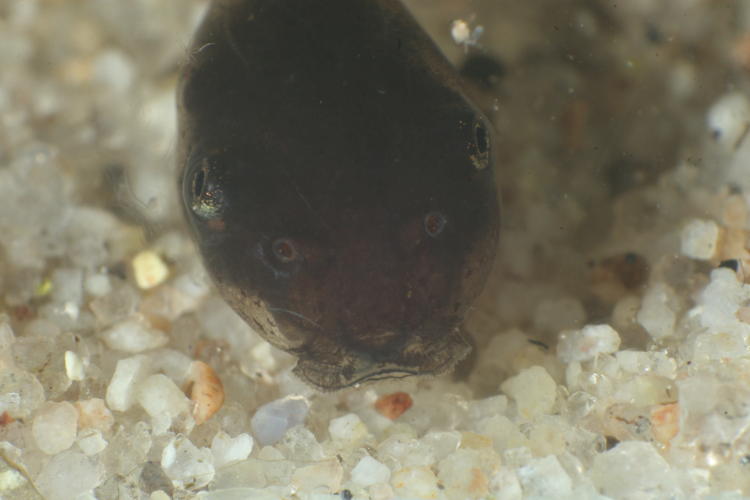
“Oh, boy!” you say, “Al’s finally done a trip to Australia [pronounced “Olls-TRAYYLL-yer” of course] and is going to feature something truly exotic for a change!” But no – Al’s still too strapped for cash to pull that one off (damn expensive mics,) and didn’t even leave the backyard for these. What I’m referring to instead is going down under the surface of the water. Hey, if everyone else can do clickbait headlines…
This saga all began when I went to a 18.927-liter bucket that I’d filled with water a few days previously, to be used for watering the various plants around the yard. As I approached, I noticed a strange pattern visible in the reflection of the sky from the surface, as if there were countless little beads of vegetable oil floating there. Close examination revealed these to be frog eggs; some opportunistic amphibian had eschewed the pond only a handful of meters away to plop its eggs into a far less hospitable location. Had I not caught the reflection, there’s a decent chance I would have deposited these eggs among the plants in the yard, especially given how they were perfectly clear with a speck the size of a pinhead within.
Now, on two occasions previously, I had found eggs in the pond and vowed to return and do some pics when I had a little time, but on both occasions they’d hatched before I had a moment to spare. This time I was more determined, but still lacking the necessary freedom; I would have the chance in the evening. When that rolled around, I showed the eggs to The Girlfriend, and a few hours later went out to collect a decent sample to shoot within the conditions of the macro aquarium.
Curiously, I was a little too late: the eggs had all hatched. I was fairly certain that they couldn’t have been there more than two days, and I thought the gestation period was longer than that (and so far, the sources I’ve found seem to confirm this,) but here we are. So the pics that I wanted of a developing frog embryo will still have to wait, but I was able to get some of the newly-hatched tadpoles anyway. I hasten to add that the image at top is not one of them, instead likely being a green frog (Lithobates clamitans) based on the size and developmental stage, being about ‘average’ size for tadpoles, roughly 25mm in length and 6-8 in width. Note the sand for scale, which makes for a good comparison with the next image:
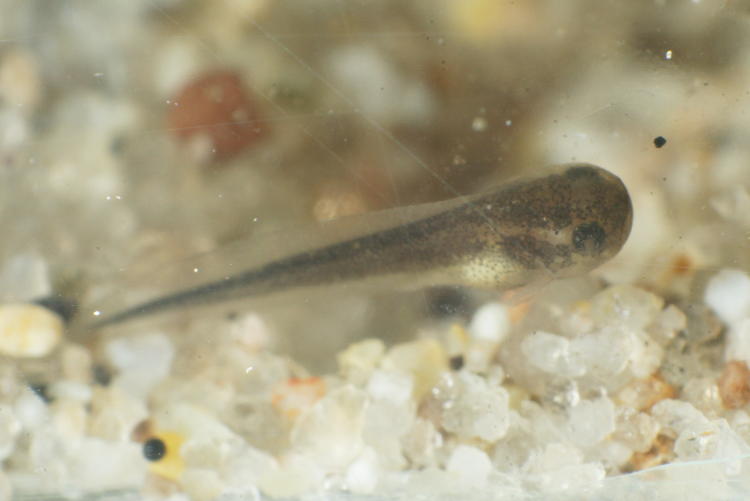
With about as much confidence as I can muster, short of seeing the eggs being laid, I’m going to say this is the newborn tadpole of a Copes grey treefrog (Hyla chrysoscelis,) mainly because that’s nearly all that we have in the yard and what’s been calling routinely every time it rains, and roughly half of the evenings otherwise. Not to mention that, being in a deep bucket, the only other choice (the aforementioned green frog) would have had a much harder time getting within. What I’m not as sure about is whether those eyes haven’t even developed yet, or if they’re merely so fine that the light from the flash was bouncing through, giving them a faint glow through the pupil. Pardon the scratches on the glass; despite my best efforts to keep it photographically pristine, it still houses sand and is a few years old now. It’s probably time to replace the macro aquarium.

Here’s another view, one that was common enough since most of them seemed to want to rest vertically against the glass. You can see the mouth, and the tiny gills that will soon enough disappear. The air bubble was trapped within the transparent gel/mucus of either the hatched eggs themselves, or the stuff that holds them all together into a blob.
This might not help a lot, but other than saying these were only a few millimeters in length, they were virtually the same size as mosquito larvae, and from a short distance could only be distinguished from those by their swimming habits; mosquito larvae thrash through the water, mostly vertically, by curling back and forth, while we all know how tadpoles swim. The bigger issue was getting enough light into the tank to focus properly with the reversed Sigma 28-105, since it’s fixed at f16 and thus very dark in the viewfinder. I have a lot of missed frames.
While collecting them, I picked up anything else from the pond that looked promising, and among those was one of the shiny gold beetles that I had photographed last year.
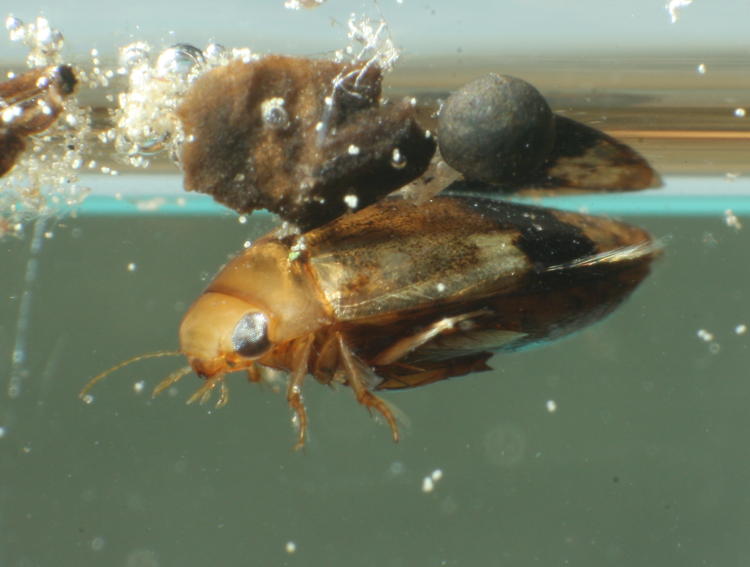
Taking a moment to try and find the species this time around, I’m going to very tentatively identify this as genus Laccophilus, possibly a Laccophilus maculosus maculosus, which looks right but is listed as twice the size – mine was only a few millimeters, about half the length of a grain of rice. It would be tempting to say this is a juvenile, but juvenile beetles don’t have wing-cases (elytra,) and in fact look entirely different from the adults – which segues into the next set of photos.
If you check out that second link in the paragraph above, you can see some photos of the larval form, which aren’t exactly beetlelike. But while I found something similar, it was waaayyyy bigger than that gold beetle and certainly not the same species, though how close the relation might be is the realm of someone more entomologically-educated than I.
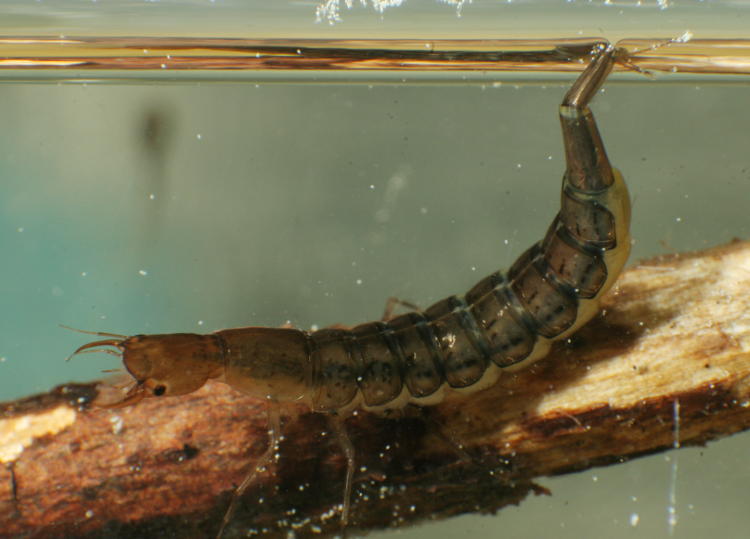
This was more like 20mm in length, and seemed very inclined to be grasping something and not swimming freely; I introduced the twig solely for this reason. But it’s definitely predatory, since those pincers aren’t for slurping algae. I caught two, and they were a lot more cooperative in posing for photos, even when one of the tadpoles acquiesced to posing alongside for another scale shot.
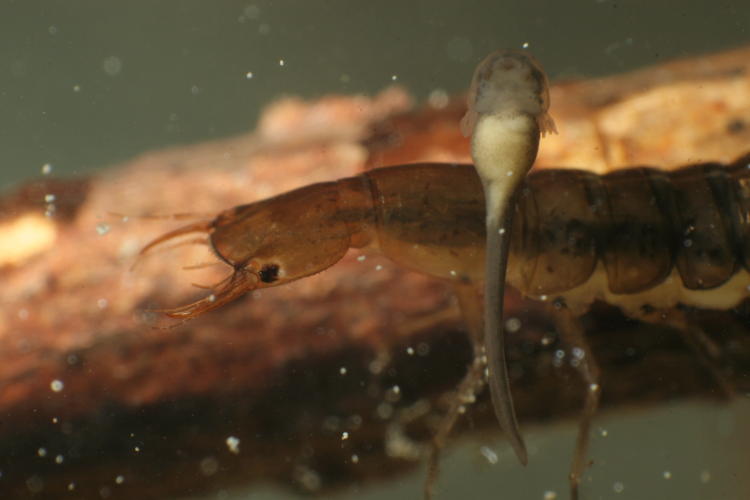
This also seemed to be a demonstration that the larva did not feed on tadpoles, though it might simply not have been hungry at this time. So while the tadpoles were difficult to get much detail about, I spent a few minutes on these larvae and did much better. Though I guess that’s all a matter of perspective.
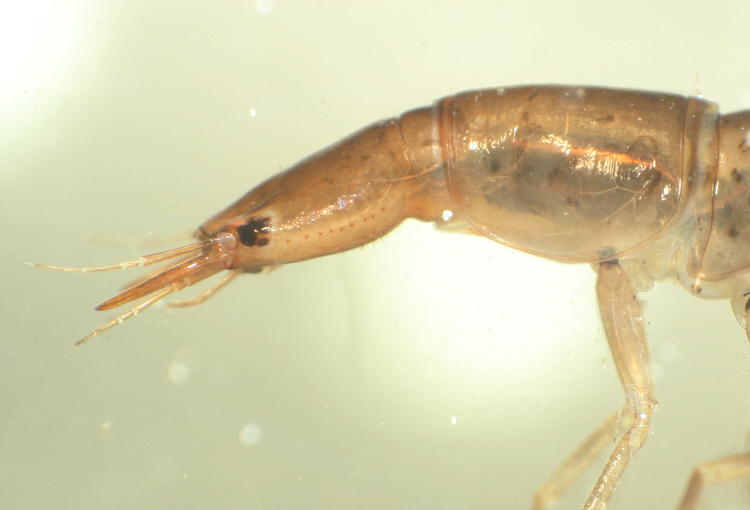
Light angle with aquarium photography can be crucial. It’s easy to get too little light from scatter of the water and simply aiming behind the subject, but it’s also very easy to get reflections from the front or rear glass and wash out all detail. Here, mostly by luck, I managed to get a nice balance to show translucence as well as getting a bit of direct shine off of the chitin to show a little texture. And we’ll see those eyes better shortly.

My focusing aid was a bright LED desk lamp on a gooseneck arm, and one of the techniques I used was to aim it through from the back, brightly outlining my subjects – it was better than trying to get enough light from the front while also staying out of my way for the extremely short working distance at this magnification. In fact, if you look at the two photos above, you’ll notice bright spots in the background; these are the individual LEDs in the lamp head. In this case, they seem to have assisted the flash in shining through the legs, which brought out some cool anatomical details (seriously, I don’t understand why you’re not as enthusiastic about this as I am.)
Now let’s get back to the eyes, et al.
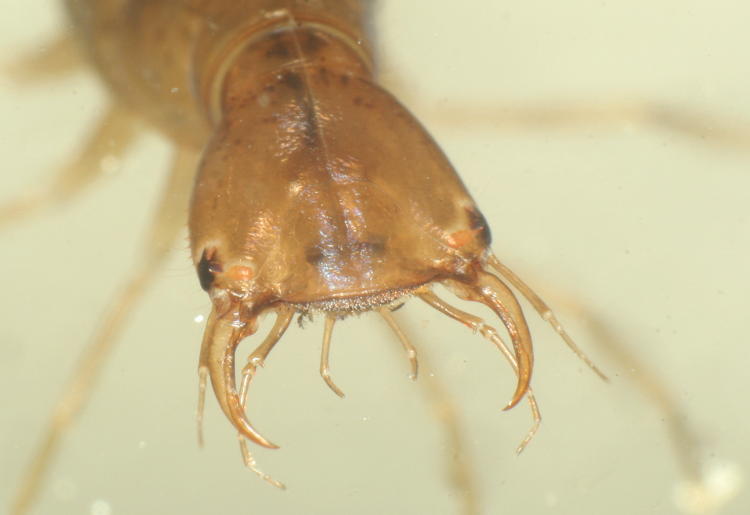
In fact, I’m not even sure those can be called eyes – they don’t seem fully developed, and it’s possible that at this stage they don’t hunt by sight, but by feel or detecting water disturbances instead. But you have to appreciate the other details in there; I’m almost certain that you’re seeing the venom channels down the middle of those chelicerae (‘fangs’.)
I just have to note this in closing: it’s very easy, even for me, to get an impression from these photos of something aggressive, vicious, and even rapacious. Their behavior in the tank, however, was extremely docile, and perhaps a tad shy. They seemed a little anxious to get a leghold of something solid and, having accomplished that, largely stayed put, though I was able to nudge them into slightly different positions for better shots. The story might have been different had I seen what triggered them into feeding behavior, but what I observed was pretty placid. Just goes to show. For instance, I’m not as dashing in appearance as you undoubtedly imagine…



















































